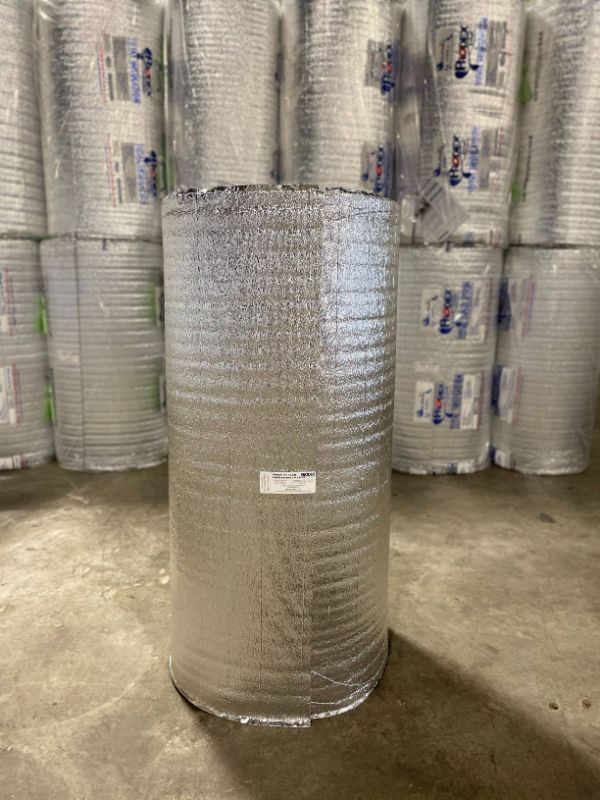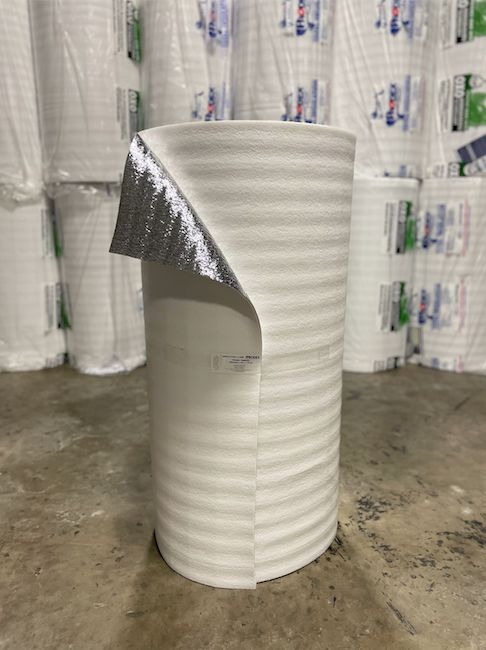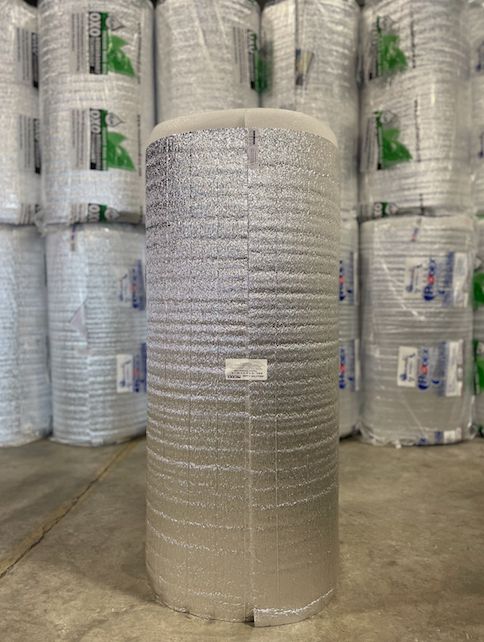Warehouse Insulation: How To Find The Right Type Of Insulation For Your Project
The average size of a warehouse in the United States is 184,693 square feet — which leaves lighting, heating and cooling amounts to approximately 9 kWh per square foot — certainly nothing to sneeze at!
Insulating your warehouse can help cut costs related to heating and cooling, protect your stored items and increase the worth of your structure.

Here, we’ll cover everything you need to know about warehouse insulation, including types, must-have features and the best warehouse insulation to invest in.
Warehouse Insulation - Why do You Need It?
If your warehouse is made of metal, you know how much the outside temperature affects the indoor environment. Temperatures that are too extreme can lead to condensation and other issues, affecting the contents stored inside your warehouse.
Without insulation, you also leave your warehouse open to issues like critters, mold and mildew. Investing in warehouse insulation can help protect the inside environment, including the goods or equipment you have stored, and keep issues at bay.
- Controls the temperature year-round to provide a healthy working and storage environment
- Controls moisture which can lead to mold within 48 hours
Protects the people that may be working inside from heat-exposure incidents
- Reduces noise to ensure healthy and stable operation, especially in noisy urban areas
- Protects investments by keeping products in good condition while they are stored or until they are delivered
- Reduces energy bills by preventing heat gain and reducing air-conditioning costs
- Reduces carbon footprint by lowering carbon emissions from the building
- Preven critters like birds, bugs and mice from nesting inside your warehouse and causing damage or other issues
Types Of Warehouse Insulation
Depending on the condition of the building and its use, one type of insulation or a combination of several options may be used to achieve better results.
This decision depends on the current insulation type (if any), the problems that need to be addressed and how accessible the areas are.
For example, you can use blanket insulation on the walls and opt for blown-in foam insulation for individual holes and cracks or places that are difficult to reach.
Be sure to pay attention to the R-value of each type of insulation — this shows the insulation’s ability to control heat transfer. The higher the R-value, the more effective it is at reducing heat gain and keeping the temperature in the warehouse consistent.
From a functional point of view, external insulation is recommended when it comes to warehouses because it wraps the building from the outside and seals tightly to stop air transfer and draughts.
Internal insulation can also be used on holes, cracks and floor crevices in old warehouses as well as in and around attic areas.
The combination of applying external and internal insulation ensures maximum protection of the warehouse, from factors like noise, heat, mold, mildew and more.
Let’s look at the options for types of warehouse insulation.
1. Fiberglass
Fiberglass insulation is the most used insulation in a warehouse. It typically has an R-value between 2.9 and 4.3 per inch, in accordance with the density and thickness of the material.
It can be stapled when it comes in batts or blown in places with difficult access when loose-fill. In general, it is preferred for warehouse walls and ceilings.
Fiberglass insulation is composed of woven fiber stands. The fiber strands contain hundreds of small air pockets. The air pockets provide the insulation. Once exposed to moisture, the air pockets fill up with water (rather than air) and the insulation loses the ability to provide r-value.
When used in conjunction with Prodex Total, fiberglass insulation can be effective in a metal building or pole barn
Prodex Total will keep moisture out of the fiberglass insulation. Prodex allows the fiber air pockets to remain dry. It's important that fiber air pockets remain dry. Once wet, fiberglass insulation loses r-value.
Buying Fiberglass Insulation
Request Fiberglass Insulation Pricing.
If fiberglass is used in a metal building or pole barn without Prodex Total, you'll have moisture issues (typically hidden behind facing), loss of r-value (consequence of the moisture), and heat gain.
2. Spray Foam
Spray foam can be applied directly to the insulated surface, is easy and clean to install, and it expands multiple times to form a layer which seals holes, cracks and gaps. It has an R-value of 3.7 to 6.5 per inch and is recommended for use on walls, floors and corrugated surfaces like the inside of the roof.
Spray foam can be used on any surface and at any angle, and it can bond materials of different structure and texture.
3. Cellulose
Made of recycled paper or denim and treated with borax, boric acid or ammonium sulfate, cellulose insulation can be blown in roof cavities, densely packed in wall cracks as retrofit insulation or wet-sprayed on new warehouses before they are fully completed. Its R-value ranges between 3.2 and 3.7 per inch and itis typically used for warehouse walls.
4. Aerogel
Aerogel insulation is recommended for cold and refrigerated warehouses for its low thermal conductivity, hydrophobic, frost-resistant, waterproof, steamproof and anti-condensation qualities.
It comes in blankets and is thin and flexible, with an R-value between 10 and 20 per inch. It is not affected by heavy loads, it is unattractive to rodents, and it is environmentally friendly.
5. Bubble
Bubble insulation R-value is a measurement of a system. The system is composed of the insulation (two reflective foil surfaces surounding air bubbles) + an air gap on. It is typically applied to roofs, walls and floors. What's the difference between bubble insulation vs. Prodex Total
6. Prodex
Prodex is made of closed cell foam and reinforced reflective foil. Its R-value ranges from 17 to 22, which makes it efficient against condensation, heat, cold and air.
Its installation is performed on dust-free surfaces, usually installed under rooflines to reflect heat and ensure a barrier against mold, mildew, rodents, bugs and birds.
The Best Time To Insulate Your Warehouse
Warehouse insulation can be installed in old buildings or during the process of the new warehouse construction.
The first option is known as retrofitting, typically done to optimize energy bills, along with working and storing conditions.
The retrofitting process can be more expensive and time-consuming in comparison to insulating a warehouse during its construction.

Warehouse insulation can help reduce thermal movements, achieve air-sealing and stop drafts, improve condensation and temperature control and improve energy efficiency.
In some cases, new insulation can be put on top of existing insulation, providing an entirely new look and increasing lighting efficiency due to the added bright reflective foil on walls and ceiling. Depending on its type, it can be also blown into cavities where access is hindered.
Retrofitting is a complex process, so hiring a professional company can help ensure that everything is done correctly.
Must-Have Features Of The Best Warehouse Insulation
When choosing insulation for your warehouse, there are several must-have features to keep in mind. If your warehouse is metal, you may want to compare metal building insulation. Make sure your insulation:
Stops Condensation
Condensation appears when there are differences between outside and inside temperature. This leads to excessive wetness or dripping, which can be harmful both for human health and for the items and equipment within the warehouse.
Prevents Heat Transfer In And Out
Metal is known for its conductivity characteristics, which means that winter and summer in a metal building can be extreme in terms of temperature. Your insulation should help protect your warehouse from outside temperatures and maintain a desired temperature indoors.
Stops Air Transfer
Airflow is directly related to the inside temperature. It can affect the humidity in the air and also transport toxic smoke and gases in the event of a fire. Make sure the insulation you choose for your warehouse has the ability to prevent air transfer from outside.
Deadens Sound Of Rain And Hail
The sound of rain or hail on a metal warehouse roof can be significantly multiplied. Make sure your insulation acts as a sound barrier to help reduce noise from storms and other weather.
Doesn’t Support Rodents, Bugs And Birds
Rodents and bugs can cause serious damage to food, equipment and other goods stored inside your warehouse. The best insulation will offer protection from mice, birds and other critters.
Installs Easily
The best type of warehouse insulation is one that is flexible, lightweight and easy to install. Whether you’re installing it yourself or hiring professionals, your insulation should be light and easy to work with.
Functions As A Vapor Barrier
Make sure your insulation helps protect your warehouse from rain. It should act as a vapor barrier to help prevent dampness from soaking through the roof and walls causing damage.
Does Not Allow Mold And Mildew
Mold and mildew can cause serious health problems and affect the condition of items stored in your warehouse. Make sure the insulation you choose offers protection against mold and mildew to help preserve a safe and healthy environment.
Prodex: The Best Type Of Insulation For Your Warehouse
You may be familiar with fiberglass, spray foam, cellulose and other types of insulation, but have you ever heard of Prodex?
Made of closed cell foam between layers of reflective foil, it has a high R-value index which stops heat transfer and beats the drastic changes of temperature levels.
Prodex is effective against condensation, it stops air transfer and its vapor barrier characteristics offer protection against wetness.
Rodents, bugs and birds cannot chew the foil layer and are not attracted to nest within this type of warehouse insulation.
It also deadens the deafening sound of hail and rain and does not allow the growth of mold and mildew.
Choose from our Prodex palette of more than 15 types to make your warehouse safe, energy-efficient and eco-friendly!
Recommended Warehouse Insulation

5M Plus: R17
Select one of these 5M items: 48 inch, Fast Action and 72 inch. Thickness: 5mm (0.2") closed cell polyethylene foam covered on both sides with reinforced reflective foil.

WHITE 5M Plus: R15.3
Thickness: 5mm (0.2") closed cell polyethylene foam with reflective reinforced foil on one side and plastic white finish film on the other side. Ideal where white finish is preferred.







